A Shipwreck Off Florida’s Coast Pits Archaeologists Against Treasure Hunters
The discovery of a legendary wreck raises questions about who should control sunken riches
/https://tf-cmsv2-smithsonianmag-media.s3.amazonaws.com/filer/20/c9/20c98edf-49e3-448a-95b3-f1d8c8906e21/header2-treasure-fever.jpg)
Most visitors come to Cape Canaveral, on the northeast coast of Florida, for the tourist attractions. It’s home to the second-busiest cruise ship port in the world and is a gateway to the cosmos. Nearly 1.5 million visitors flock here every year to watch rockets, spacecraft, and satellites blast off into the solar system from Kennedy Space Center Visitor Complex, reminding us of the restless reach of our species. Nearly 64 kilometers of undeveloped beach and 648 square kilometers of protected refuge fan out from the cape’s sandy shores. And then there’s the draw of relics like Turtle Mound, a vast hill containing 27,000 cubic meters of oyster shells left by Indigenous tribes several thousand years ago.
Yet some of Cape Canaveral’s most storied attractions lie unseen, wedged under the sea’s surface in mud and sand, for this part of the world has a reputation as a deadly ship trap. Over the centuries, dozens of stately Old World galleons smashed, splintered, and sank on this irregular stretch of windy Florida coast. They were vessels built for war and commerce, traversing the globe carrying everything from coins to ornate cannons, boxes of silver and gold ingots, chests of emeralds and porcelain, and pearls from the Caribbean—the stuff of legends.
Cape Canaveral contains one of the greatest concentrations of colonial shipwrecks in the world, though the majority of them have never been found. In recent years, advances in radar, sonar, scuba diving, detection equipment, computers, and GPS have transformed the hunt. The naked eye might see a pile of rocks, centuries of concretions, crusts of coral, decayed and worm-eaten wood, oxidized metal—but technology can reveal the precious artifacts that lie hidden full fathom five on the ocean floor.
As technology renders the seabed more accessible, the hunt for treasure-laden ships has drawn a fresh tide of salvors and their investors—as well as marine archaeologists wanting to exhume the lost relics. But of late, when salvors have found vessels, their rights have been challenged in court. The big question: who should have dominion over these Golcondas of the seas? High-stakes fights over shipwrecks pit archaeologists against treasure hunters in a vicious cycle of accusations. Archaeologists regard themselves as protectors of history and the human story, and they see salvors as careless destroyers. Salvors feel they do the hard grunt work of searching for ships for months and years, only to have them stolen out from under them when discovered.
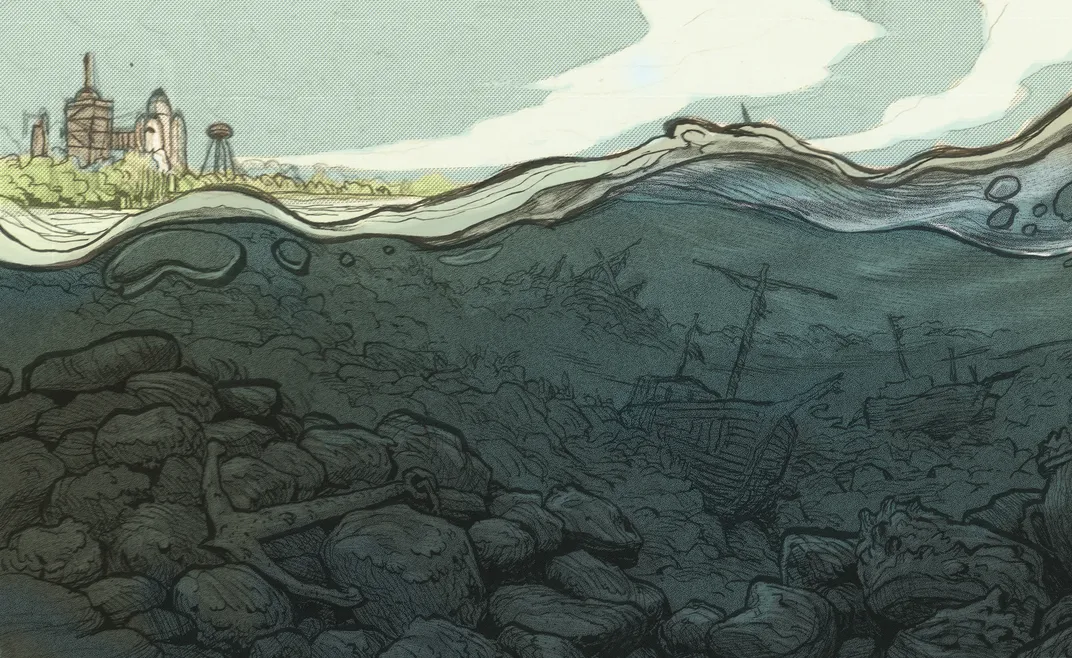
This kind of clash inevitably takes place on a grand scale. Aside from the salvors, their investors, and the maritime archaeologists who serve as expert witnesses, the battles sweep in local and international governments and organizations like UNESCO that work to protect underwater heritage. The court cases that ensue stretch on for years. Are finders keepers, or do the ships belong to the countries that made them and sent them sailing centuries ago? Where once salvors and archaeologists worked side by side, now they belong to opposing, and equally contemptuous, tribes.
Nearly three million vessels lie wrecked on the Earth’s ocean floor—from old canoes to the Titanic—and likely less than one percent have been explored. Some—like an ancient Roman ship found off Antikythera, Greece, dated between 70 and 60 BCE and carrying astonishingly sophisticated gears and dials for navigating by the sun—are critical to a new understanding of our past. They are Rosetta stones of the sea. No wonder there is an eternal stirring among everybody from salvors to scholars to find them.
***
In May 2016, a salvor named Bobby Pritchett, president of Global Marine Exploration (GME) in Tampa, Florida, announced that he had discovered scattered remains of a ship buried a kilometer off Cape Canaveral. Over the prior three years, he and his crew had obtained 14 state permits to survey and dive a nearly 260-square-kilometer area off the cape; they did so around 250 days each year, backed by investor funds of, he claims, U.S. $4-million.
It was hard work. Crew members were up at dawn, dragging dual booms with magnetometry sensors from their expedition vessels back and forth, back and forth, day in and day out, month after month, year after year, to detect metal of any kind. Using computer technology, Pritchett and his crew created intricate, color-coded maps marked with the GPS coordinates of thousands of finds—including spent rockets, airplane shrapnel, and shrimp boats—all invisible under a meter of sand. The targets lay like an explosion of iridescent black, green, blue, and yellow stars on an image of the ocean. “We would find a target, then go back and dive it, and move the sand to see what it was,” he says. “We did that thousands of times until we finally discovered targets of historic importance.”
One day in 2015, the magnetometer picked up metal that turned out to be an iron cannon; when the divers blew the sand away, they also discovered a more precious bronze cannon with markings indicating French royalty and, not far off, a famous marble column carved with the coat of arms of France, known from historical engravings and watercolors. The discovery was cause for celebration. The artifacts indicated the divers had likely found the wreck of La Trinité, a 16th-century French vessel that had been at the center of a bloody battle between France and Spain that changed the fate of the United States of America.
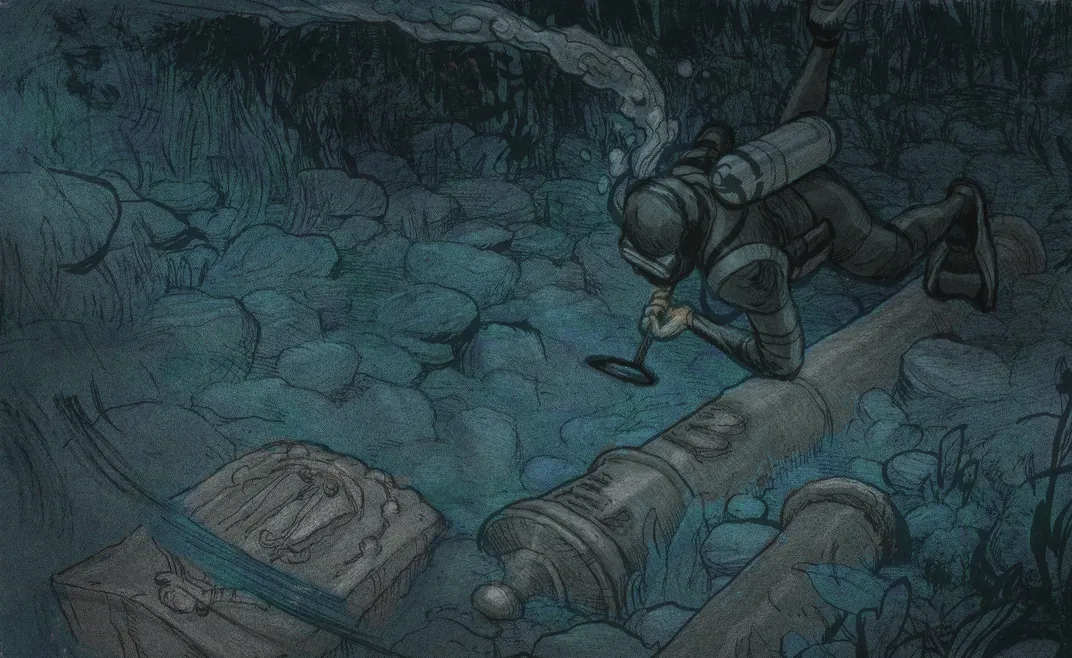
And then the legal maelstrom began, with GME and Pritchett pitted against Florida and France.
“La Trinité is a ship tied to the history of three nations—France, Spain, and the United States,” explains noted maritime archaeologist James Delgado, the senior vice president of SEARCH, a U.S.-based cultural resources organization with offices in Jacksonville, Florida, and a specialty in archaeology. Delgado has participated in over 100 shipwreck investigations around the world and is the author of over 200 academic articles and dozens of books. “It tells a story of fortunes, empires, and colonial ambition that carries an international, shared cultural heritage.”
“In the world of ships and treasures, there’s really no better story than La Trinité,” agrees archaeologist Chuck Meide, director of archaeological maritime research at the St. Augustine Lighthouse and Maritime Museum in Saint Augustine, Florida. Meide—a tall, broad-shouldered 48-year-old with a blond ponytail and a sunny smile—led a six-week expedition sponsored by the state and federal governments in 2014 to try to find La Trinité. The ship has fascinated him since he first heard about it in the fourth grade. “It is critical to the origin story of Florida, and thus America. It’s also the first example of a group that faced religious persecution in Europe coming to America to seek freedom. La Trinité has been on everybody’s minds for years.”
“When I viewed the videos,” recalls Floridian John de Bry, a historian specializing in maritime archaeology who was given an early peek at the footage by Pritchett, “I thought, my God, this is the most important shipwreck ever found in North America.”
***
La Trinité set sail for what is now Florida in 1565—a full half-century before pilgrims landed on Plymouth Rock—leading a fleet of six other ships and guided by Captain Jean Ribault, who operated under the order of King Charles IX of France. The fleet was packed with munitions, gold, silver, supplies, livestock, and nearly 1,000 soldiers, seamen, and French Huguenot colonists—Protestants seeking religious freedom. The goal was to replenish France’s Fort Caroline, on the northeast coast of Florida, and grab a foothold in America—much of which Spain had already claimed. Within weeks of the fleet’s departure, the Spanish king sent his own captain, Pedro Menéndez de Avilés, along with five Spanish ships, to intercept the French. He ordered Menéndez to drive out the French with “fire and blood.”
The French arrived before the Spanish could catch up, but La Trinité and three of the other French ships were wrecked in a storm. Emboldened, Menéndez led his men on a march through swampy wetlands to launch a surprise attack on Fort Caroline. Over 100 French perished. Not long after, hundreds more who refused to convert to Catholicism fell to the sword of Menéndez, in an attack so brutal that the area is still called Matanzas (Slaughter) Inlet. Menéndez founded Saint Augustine, today the oldest city in the United States. Spain now definitively controlled a huge chunk of the country—La Florida, which contained present-day Florida plus parts of Georgia, Alabama, Mississippi, South Carolina, and southeastern Louisiana. The Spanish almost immediately began building new forts up and down the coast, as far north as the Carolinas. Though Spain suffered some losses over the years, it remained in control of La Florida (aside from a brief intercession by the British) until 1821 when the United States assumed control. Americans tend to think of themselves as a British colony that won freedom in 1776, but the country was first a Spanish colony and Menéndez a founding father about whom one scholar declared: “Spain owed him a monument; History, a book; and the Muses, a poem.”
The tides of history, untold wealth, clashing religious beliefs, a battle over the United States of America—what find could be richer? Back then, says Delgado, “we were on the brink of what would become a global society. It was a time when the movement of a ship could change the world.” La Trinité, by sinking, did just that.
In June 2016, shortly after Pritchett made the announcement about his discovery, Florida began to confer with France. “This is an unusual, and potentially precedent setting situation,” Timothy Parsons, historic preservation officer at the Florida Department of State, wrote in a letter to Pritchett on June 8. On June 20, he wrote again: “As you’ve pointed out, if these sites belong to Ribault’s fleet they could be extremely significant to the history of Florida, and France. With that in mind, we are doing our diligence to reach out to the French government for input. We are also considering implications related to the Sunken Military Craft Act.”
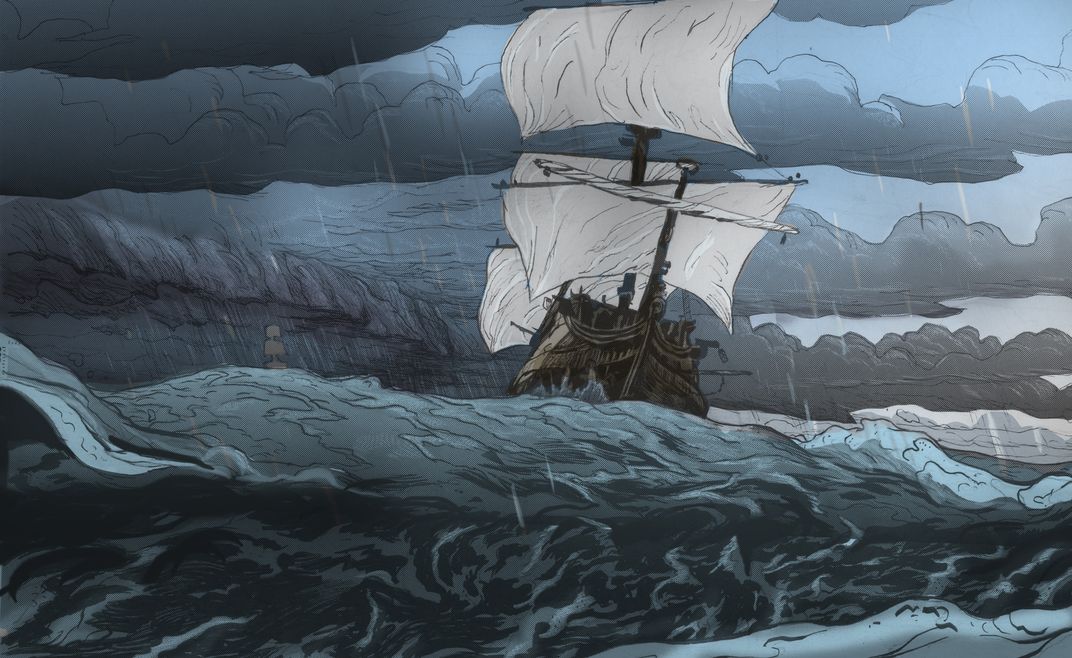
The Sunken Military Craft Act of 2004, a U.S. federal act, protects any vessel that was on a military mission, allowing the originating country to claim their ship even centuries later. By November 2017, France had officially claimed ownership of the artifacts in the admiralty division of the U.S. district court in Orlando. Florida supported that claim. Pritchett, in turn, contended that nobody had yet proven the artifacts belonged to La Trinité, and that evidence suggested the ship might actually lie about 145 kilometers north, near where Chuck Meide had looked. Over time, Pritchett came to believe that the artifacts might belong to a Spanish vessel that had stolen the French cannons and column. In the summer of 2018, two long years after Pritchett’s discovery, the federal district court concluded that the remains were indeed those of La Trinité and ruled in favor of France. The standard agreement between Florida and salvors—where the salvor reaps 80 percent of the profits from a find and the state takes 20 percent—was dismissed. In December 2018, the State of Florida and the Republic of France announced they had signed a declaration of intent to “embark on a historic partnership to research and preserve the Trinité shipwreck.” They are still working out the details.
For Pritchett, the decision was devastating. Millions of dollars of investor funding and years of labor were lost. But this is far from the first time a salvor has lost all rights to a discovery. In 2012, for instance, Spain won a five-year legal battle against Odyssey Marine Exploration, which had hauled 594,000 gold and silver coins from a Spanish wreck off the coast of Portugal across the Atlantic to the United States. An even more notorious case was that of treasure hunter Phil Greco, who with the aid of local fishermen spent 11 years off the coast of the Philippines collecting artifacts spanning 2,000 years of Chinese history. He packed his home in California with 23,500 pieces of porcelain and thousands of plates from the Ming Dynasty, some as heavy as 45 kilograms. The collection was to be auctioned off at Guernsey’s Auction in New York City, New York, but shortly after Greco unveiled it, he found himself the target of angry archaeologists and the Philippine government, who claimed his permits were invalid. The legal quagmire spun out over years and eventually ruined him. “Treasure hunters can be naive,” says attorney David Concannon, who has had several maritime archaeologists as clients and represented two sides in the battles over the Titanic for 20 years. “Many treasure hunters don’t understand they are going to have to fight for their rights against a government that has an endless supply of money for legal battles that treasure hunters are likely to lose.”
Pritchett did not appeal the State of Florida’s decision. Instead, he mounted a new legal battle and says he wants $250-million “for what they have done and cost GME.” Among other allegations, the suit maintains that Florida breached GME’s intellectual property by sharing the GPS coordinates with France without the company’s knowledge or permission. “The only reason the region has any archaeological knowledge is because of treasure hunters that do it the right way,” Pritchett contends.
***
If the story of La Trinité were an epic novel, then Chuck Meide and Bobby Pritchett would be opposing and equally dashing figures, both persuasive and indefatigable men intimately yoked to the ship’s fate—yet viewing each other with equal measures of derision.
The 56-year-old Pritchett built over 900 homes in southern Georgia before deciding to “follow my dream—treasures in the sea.” He is a tall, slender man whose measured way of speaking, silvery-brown hair, and soft, fine features belie an exacting and obsessive nature. At one point, he had 62 diving certifications, all at the level of an instructor, for everything from cave diving to rescue diving. At the home he recently built in the enclave of Sebastian, Florida, there’s a clean-swept, tropical-bright feel; nearly 70 spiral-bound and hard-spine notebooks pack his oak shelves. They document finds from many of the dives his company has taken over the past 10 years. “We GPS and photograph and document everything we find,” he explains, “even if it’s a steel-toe shoe, airplane engine, shrimp boat, rocket, fish trap, or tire.”
The first time I spoke with Pritchett—in June 2018—he woke me up. A perpetual early riser, he was returning my phone call, at around 6:00 a.m. “I don’t want to talk about the case,” he began, referring to the court battle over La Trinité that was about to conclude, and then he proceeded to talk off the record for nearly an hour. This was my first hint that Pritchett was obsessed.
Meide, at 48, is also exacting and driven by his own passions—particularly La Trinité. He not only read about it in school, he recalls his father telling him that Menéndez and his men may have marched right through their backyard. Those sunken ships were always at the back of his mind, and in 2000, at an archaeology conference in Quebec, he turned to colleague John de Bry and said, “We need to figure out how the heck to find those Ribault ships.” In the late summer of 2014, he thought he might achieve his dream. After obtaining over $100,000 in funding from the U.S. National Oceanic and Atmospheric Administration, the State of Florida, the St. Augustine Lighthouse and Maritime Museum, and other sources, he and a crew went looking for the ship. They spent weeks surveying a stretch of the ocean 9.3-kilometers long, analyzing the data, and inspecting the targets they had found. But Meide and his crew turned up only modern debris.
Meide’s first reaction when he heard La Trinité had likely been discovered was joy, but his second reaction was horror. “The worst thing that could happen to a shipwreck is to be found by a treasure hunter. Better that it not be found at all,” he says, rocking back in his desk chair on the day in late August that I visit him at the St. Augustine Lighthouse and Maritime Museum. He was worried about the worst-case scenario—Pritchett going out at night, diving to the wreck, and stealing artifacts.
Meide’s dread was only amplified when, as he puts it, “Bobby Pritchett went rogue.” As Florida aligned itself with France, Pritchett’s dreams of working with the state to excavate the ship and taking an 80 percent cut evaporated. Meide cringed when he learned that Pritchett was alleged to have taken artifacts such as a cannonball, pickaxe, and ballast stones from the wreck without permission of the state. Says Meide: “He used those to go to admiralty court and try to get ownership of the wreck that way.” Admiralty laws pertain to the open seas, beyond state waters. The bid did not succeed, and Pritchett was ordered to return the artifacts to the Florida Department of State. In Pritchett’s interpretation of his permit, however, he was allowed to bring up artifacts.
Salvors like Pritchett protest that archaeologists are willing to let ships decay in the dark deeps. And what if part of the appeal is a gargantuan cache of coins and gold? Pritchett makes no bones about the fact that the potential profit of treasure hunting historical finds is a powerful lure. “I can go back to developing homes and make three million gross profit a year,” he says. “But I could go out and find one ship that’s worth half a billion.”
On the web’s most popular treasure-hunting forum, treasurenet.com, Pritchett took the moniker of Black Duck (an homage, he says, to the moniker Black Swan, taken by the late “godfather of treasure hunting,” Robert Marx). There, he poured out his thoughts and gripes during the court battle over La Trinité, and estimated the worth of his finds. On April 30, 2017, Black Duck posted, “I believe we are looking at 50–60 mil for what we have found already.” De Bry, the historian, and others vehemently disagree. “The figures Mr. Pritchett gave are absolutely ridiculously inflated,” de Bry says. “One million dollars for a bronze cannon? We know from auction record that similar cannons have sold for $35,000 to $50,000, regardless of their origin.”
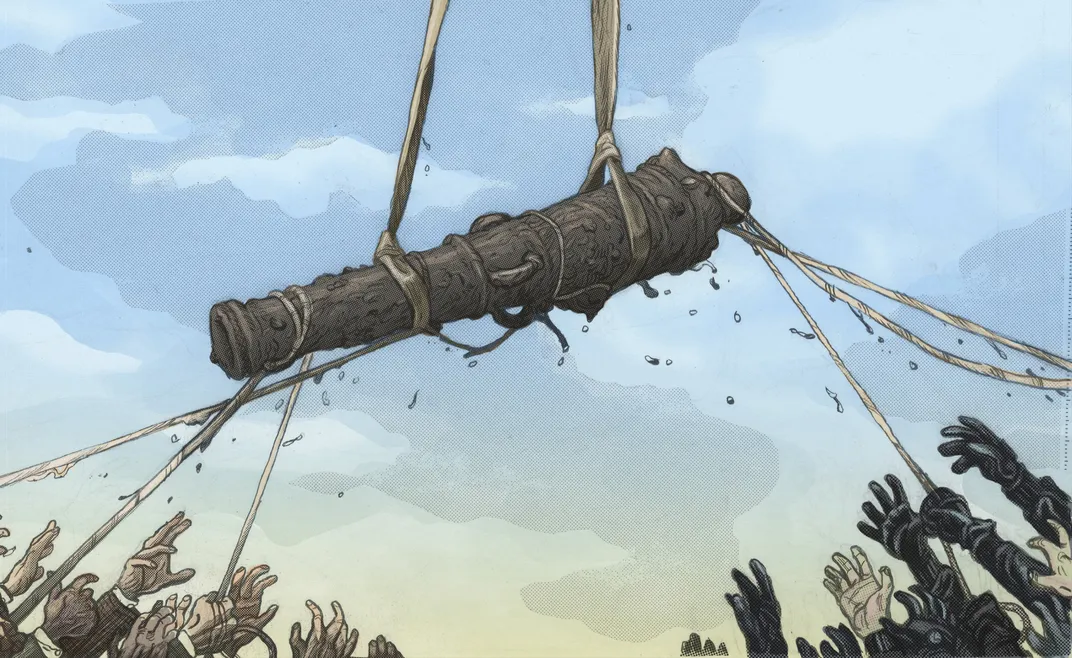
Putting an inflated price on artifacts rather than viewing them as cultural and historical treasures that transcend any price is what inflames many archaeologists. For the archaeologist, everything in a wreck matters, explains Delgado. “Archaeology is more than blowing a hole in the bottom of the ocean to find a monument and say, ‘What is it worth?’” he says, “Hair, fabric, a fragment of a newspaper, rat bones, cockroach shells—all things speak volumes. We don’t want artifacts ending up on a mantelpiece or in a private collection instead of taking us on a journey of understanding. I understand the magic of that journey. I was one of those kids who had my first dig at age 14.”
Conservation of a ship can go on for years and with a kind of dedicated care that is breathtaking. It took over a decade to treat, extract, mend, and piece together a million shards of broken glassware from the famous “glass wreck,” an 11th-century Byzantine merchant ship discovered in the Serçe Limani bay off the coast of Turkey in the 1970s. The ship was excavated by the Institute of Nautical Archaeology and Texas A&M University. The restored glass vessels from the ship now constitute the largest collection of medieval Islamic glass in existence. George Bass, one of the great, early practitioners of underwater archaeology, who long held a teaching and research chair in nautical archaeology at Texas A&M University, coauthored two volumes on the ship’s excavation. He explains why artifacts must be preserved: “We excavated a seventh-century Byzantine ship found in Yassada, and we must have raised 1,000 amphoras that all looked identical, but then one of the Turkish graduate students noticed graffiti on the glass, and that graffiti alone enabled us to determine that the ship belonged to a church and was carrying wine over land and sea to Byzantine troops in a certain city.”
Bass has testified in court against treasure hunters, but says archaeology is not without its own serious problems. He believes archaeologists need to do a better job themselves instead of routinely chastising treasure hunters. “Archaeology has a terrible reputation for not publishing enough on its excavations and finds,” he says. Collating data, exhuming and meticulously preserving and examining finds, verifying identity and origin, piecing together the larger story, and writing and publishing a comprehensive paper or book can take decades. A bit wryly, Bass describes colleagues who never published because they waited so long they became ill or died. “We are likely never to publish the third volume on the Serçe Limani, for example,” he says, “since my colleague is as old as I am. He’s 86.”
Who is more at fault, Bass asks, the professional archaeologist who carefully excavates a site and never publishes on it or the treasure hunter who locates a submerged wreck, salvages part, conserves part, and publishes a book on the operation? “I’m speaking of [salvor] Tommy Thompson and his discovery of the SS Central America,” he says. “He published America’s Lost Treasure in 1998.” On the other hand, Bass adds, Thompson was dishonest; in 2000, he sold gold recovered from the ship for $52-million, and in 2015, was arrested for swindling his investors out of their share; a jury awarded the investors $19.4-million in compensatory damages.
Pritchett concedes that his find deserves careful excavation and preservation. “I think what I found should go in a museum,” he says. “But I also think I should get paid for what I found.”
Indeed, it’s a bit of a mystery why nations, states, archaeologists, and treasure hunters can’t work together—and why salvors aren’t at least given a substantial finder’s fee before the original owner takes possession of the vessel and its artifacts. “That’s actually a good idea,” says Bass, noting that the Italian government gave Stefano Mariottini, a chemist from Rome, a finder’s fee for his chance discovery of the famous Riace Warriors, two full-sized Greek bronzes cast about 460–450 BCE. Mariottini had been scuba diving when he found them.
***
During precolonial and colonial times, pirates, naval battles, and storms converged again and again to send whole armadas and their riches down to the shallow, coral-dotted waters off Florida’s boundaries.
Today, the state’s famed “treasure coast” stretches from Roseland to Jupiter Sound. The name was inspired by 11 Spanish ships, all from a single fleet, that went down in 1715. In 1928, a salvor named William J. Beach located Urca de Lima, part of the 1715 fleet. He raised 16 cannons and four anchors, which were put on display in the town of Fort Pierce. That was the genesis of treasure fever in the United States; from then on, the hunt for shipwrecks was on. Between 1932 and 1964, more than 50 leases were issued by Florida to salvors.
In 1961, a treasure hunter named Kip Wagner and his crew found and recovered about 4,000 silver coins from the treasure coast. They formed a team, called Real Eight, and ultimately salvaged over $6-million in coins and artifacts from the 1715 Spanish fleet. The collection was impressive enough to grace the January 1965 issue of National Geographic.
Back then, there was no animosity between archaeologists and treasure hunters, who often worked side by side. John de Bry first dove with Wagner in the 1960s, after a personal letter of introduction from Jacques Cousteau. Says de Bry, “At that time, underwater archaeology was in its infancy, and we didn’t think there was anything wrong with what Kip Wagner was doing.”
In the 1960s, underwater archaeology was a field so small that the heads of projects around the world could fit into one conference room. The instruments were crude by today’s standards; Wagner detected his first ship using a 12-meter naval boat and a $15 metal detector. Today, explorers use magnetometers that can detect buried metal, sonar devices, hydraulic dredges, and machines called prop-wash deflectors that help blast sand off the ocean floor. What used to be marked with a buoy alone is now marked by GPS as well, with far greater accuracy for return dives. Commercial divers can go down an astounding 300 meters today, adjusting gases they breathe as they go, guided by small computers they take with them.
After Wagner’s success, Florida established laws to regulate shipwreck discoveries. For decades, treasure hunters ruled the day, sometimes taking home hundreds of millions of dollars after winning tough court battles. Salvors found and fought for rights to the “Jupiter wreck,” discovered in 1988 south of Jupiter Inlet near Palm Beach county. They recovered over 18,000 silver coins. The world’s most famous explorer of the high seas, Mel Fisher, won rights to Spain’s Nuestra Señora de Atocha, which sunk near the Dry Tortugas islands, over 56 kilometers west of Key West, Florida, in 1622. The discovery was valued at nearly $400-million. Fisher searched for that ship for 16 years, finding telltale silver bars and cannons from the ship along the way and then discovering the ship and its motherlode of emeralds and gold in 1985. He fought Florida for eight years before he won exclusive rights in 1992.
Fisher’s case was a turning point, however. His case rested on the fact that the boat lay in the Straits of Florida, which in 1974 had been designated part of the Atlantic Ocean, thus federal and not state waters. Federal admiralty laws trumped state laws. Fisher proved that Spain had effectively abandoned the ship by never searching for it. His case, which went all the way to the United States Supreme Court, set a precedent that extended salvors’ rights to other wrecks at sea. Salvors then began to sue Florida, citing Fisher and admiralty rights.
At the same time, the public’s perception of shipwrecks was evolving—or, one might say, molting into something entirely new. Countries like Spain had felt the sting of losses—not only of buried riches but also of cultural heritage. Maritime archaeology had matured, with doctoral programs at numerous universities in the United States, including Florida and Texas. According to David Concannon, the maritime attorney who handled much of the litigation over the Titanic, the salvage of the Titanic in 1987 raised alarm bells among governments and archaeologists around the world. Archaeologists, says Concannon, recoiled at a proposal by a salvor who planned to haul up the contents of the Titanic with a giant claw—a very crude technique.
In 1988, the United States enacted the Abandoned Shipwreck Act. The law dictates that rights to newly discovered ships within 22 kilometers of shore belong to the states. Beyond 22 kilometers, ships are considered lost on the high seas (therefore potentially available to salvors). For a wreck to be considered the property of a state, however, it has to be “embedded” in the mud and sand, and the meaning of the term has been argued in courts.
Then, in 2000, Spain won a historic case that helped formalize a new view of cultural rights to sunken ships. After a long battle, a federal appeals court ruled that Spain had rights to two ships treasure hunter Ben Benson had found off the coast of Virginia, estimated to be worth $500-million in coins and precious metals. Both La Galga (which sank in 1750) and Juno (which sank in 1802) were returned to Spain, and Spain allowed the artifacts to be exhibited in Virginia indefinitely. The United Kingdom and the United States had sided with Spain, suggesting that in the future, governments would cooperate with distant countries to the detriment of treasure hunters.
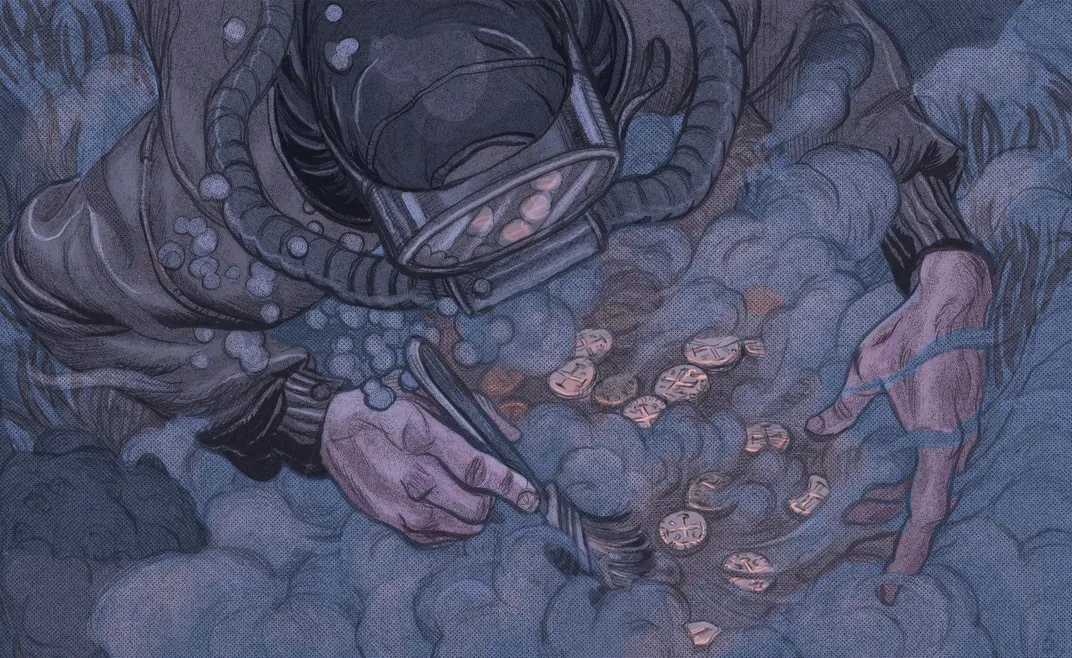
The attorney who led that case, James A. Goold of Covington & Burlington in Washington, D.C., is now a legend in nautical archaeology. An archaeology student in the 1970s and a diver who spends his spare time on nautical archaeology projects, he was knighted by Spain in 1999 for his efforts in this case. At the time, recalls Goold, “Virginia was giving permission to treasure hunters to explore sunken Spanish navy ships. It hadn’t dawned on people that the sunken ships of other nations are entitled to the same protection we expect for our own ships in foreign waters.”
Another blow to treasure hunters came in 2001, when UNESCO established the Convention on the Protection of the Underwater Cultural Heritage, which protects all underwater traces of human existence that are more than 100 years old. Though the United States has not ratified this convention, 58 countries have signed on, including Spain, France, and Italy, and the ripple effect is felt by all.
Once the Sunken Military Craft Act came into effect in 2004, countries had two layers of U.S. legal protection. The military craft act has had huge repercussions for treasure hunters since most European ships sent sailing on the high seas centuries ago carried artillery and were effectively warships, even when they had no intention of going to war.
When Goold quashed Odyssey Marine Exploration’s claim to the wreck off Portugal in 2012, salvors reeled again. With that victory, which earned Goold the Commander’s Cross of the Order of Merit from Spain, the lawyer had fundamentally reshaped interpretation of maritime law and how we approach treasure hunting. Gone are the days of camaraderie, when archaeologists regularly dove alongside salvors. In Concannon’s view, “In the early to mid-1990s, we were trying to get everybody to work together, but it was like an intifada.” Though independent archaeologists will sometimes work with treasure hunters, the two sides are no longer allied.
For Goold, it’s simple: “Ships that belong to foreign nations remain the property of foreign nations and the wishes of foreign nations are to be respected.” Not surprisingly, it was Goold to whom France turned when fighting for rights to La Trinité.
***
Talk to almost any maritime archaeologist, and his or her contempt for treasure hunters is palpable. As Paul Johnston, the curator of maritime history at the Smithsonian Institution’s National Museum of American History in Washington, D.C., points out, you can’t break into your neighbors’ house and steal all of their valuables.
Even the rare archaeologist who sympathizes with treasure hunters seems to also sigh with exasperation: “They’re like children who just got finished reading Treasure Island,” says Donald Keith, a founder of Ships of Discovery, an educational non-profit in Santa Fe, New Mexico. But talk to any treasure hunter, and his or her simmering resentment of archaeologists is equally vivid. “I call them ‘burearchs,’” the late Robert Marx the so-called father of treasure hunting in America, said in the fall of 2018.
Yet when you sit down with the men and women who pursue underwater exploration, they seem more similar than not. They are built of the same clay: adventurers, scuba divers, explorers in love with the deep-blue sea, and to a last one they are mesmerized by shipwrecks. Meide, the chief archaeologist at the Saint Augustine museum, remembers the first time he felt the ribs of a wrecked ship in mud. “I thought to myself, this could have been a Spanish merchant ship. It could have been a pirate ship. From that point I never quit. I knew this is what I want to do.”
Those who are driven by obsession are usually relentless about fine details. Meide boasts about finding a mouse toenail and spider jaw on expeditions. These sorts of discoveries evoke the daily life and diseases of long-ago seafarers. In touring the museum, he shows me how concretions—hardened muddy gunk that cover an artifact—are chipped away with tiny tools like dental picks for weeks and months at a time.
Salvors and archaeologists are bonded by the ships, whether they like it or not. If the treasure hunter finds the ship, the archaeologist pieces together its smashed hull, raises coins and ingots out of the ocean, restores its cannons. And for both, it’s a way of holding and perhaps reshaping our view of the past. The 16th century is “when the Old World and the New World came to meet each other and everything changed,” Meide rhapsodizes. “This is the pivotal century.”
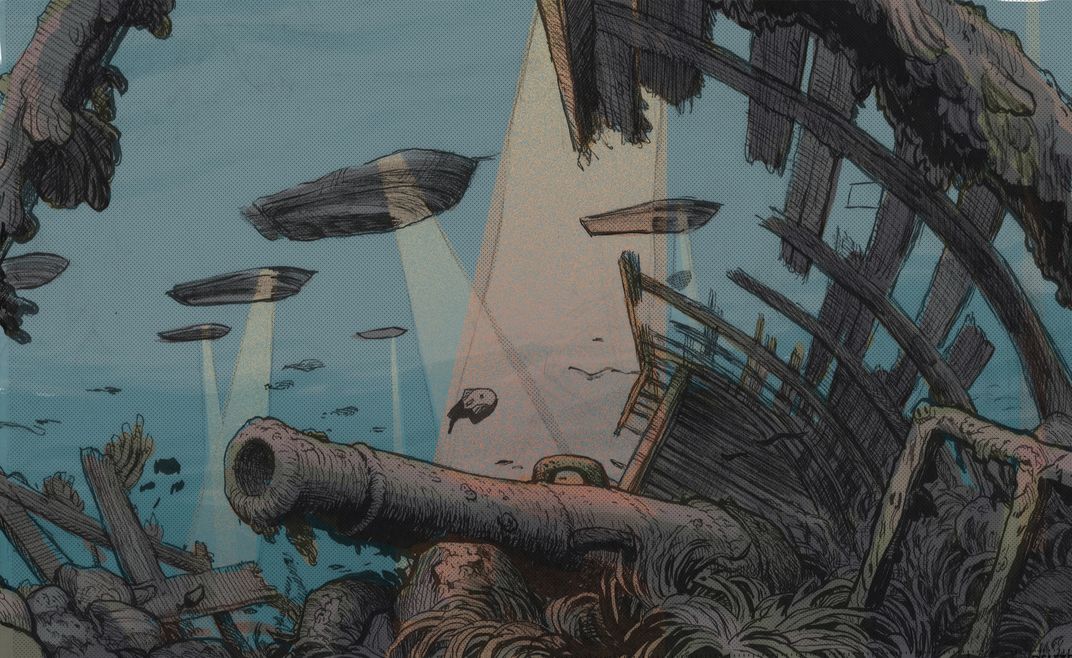
At 76, de Bry can’t get ships out of his blood either. He has been diving for wrecks since he was a teenager and went scuba diving recently to investigate a 1400s shipwreck in Jamaica. He grew up in both France and the United States and made three trips to the National Library of France in 2017 to research La Trinité. “I found a gold mine of manuscript documents pertaining to the dispatches between the French ambassador to the Spanish court and King Charles IX and Catherine de’ Medici,” he says. One of the letters from Queen de’ Medici made clear that, though the French monarchy may have denied it, they knew all along they had sent “seditious” Protestants to America. And that kind of find, says de Bry, “is treasure more important than anything else you can think of. It’s the treasure of history.” De Bry is likely to be hired to help analyze the artifacts and establish their place in history.
To every man a different treasure, but to each an irresistible force that looms larger than their own lives. As Joseph Conrad wrote in Nostromo, “There is something in a treasure that fastens upon a man’s mind. He will pray and blaspheme and still persevere, and will curse the day he ever heard of it, and will let his last hour come upon him unawares, still believing that he missed it only by a foot.”
***
At Pritchett’s house in Sebastian, a stone’s throw from a museum built by Mel Fisher, the salt air is balmy, the South Florida light weightless and brilliant. The receding ocean and its buried ships still beckon. Laws may have tightened and governments may have claimed his finds, but he is now refocusing on wrecks that exist beyond the reach of such regulations. The dream will not die. “I’m going out to international waters next time, where local governments can’t interfere,” he says. “I can tell you, there are ships in deep water not far from where I live now that are worth billions of dollars.”
Meanwhile, James Delgado’s firm, SEARCH, has offered to facilitate a unique international partnership between Florida and France to excavate and restore La Trinité. Ships, says Delgado, contain “the story of all of us.” We are, in every age and at every turn, humans caught in the fateful gears of events much larger than ourselves. “By better understanding these colonial encounters with a new world,” says Delgado, “we can ready ourselves for the time when humanity sets foot on other planets.” And so it seems fitting, almost fated, that one of the greatest shipwreck finds in recent history occurred at the very spit of land where rockets regularly blast off into space.
Related Stories from Hakai Magazine: